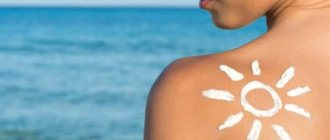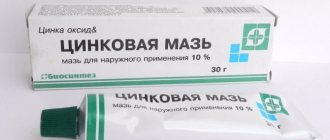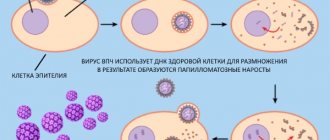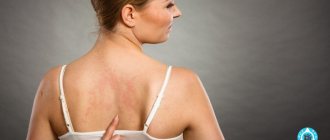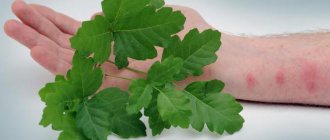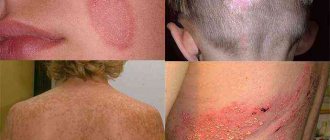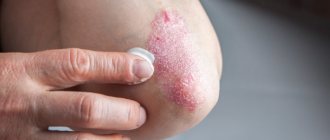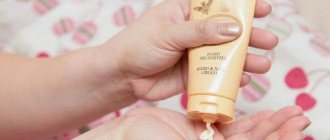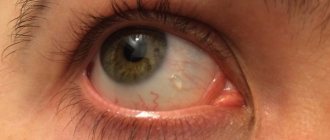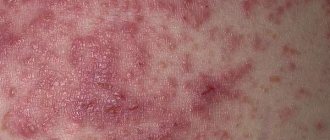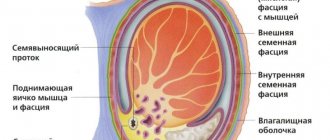Probable causes
Irritation on the legs in allergic diseases is the result of the body's active response to contact with a foreign substance. An increase in the level of immunoglobulins, the release of histamine, and the production of inflammatory mediators cause negative symptoms when the papillary receptors of the skin are irritated.
Increased vascular permeability allows certain blood components to penetrate into the intercellular space, and swelling appears. The longer the contact with the allergen lasts, the more active the reaction is. Some types of urticaria, for example, mechanical or cold, disappear quickly enough when the irritant is eliminated.
Allergic reactions in the lower extremities occur under the influence of external factors:
- wearing cheap, non-breathable, tight shoes;
- negative effects of plant pollen, house dust or pet hair;
- prolonged contact of the epidermis on the legs with synthetic fabrics that do not allow air to pass through;
- increased sweating when wearing shoes made of low-quality materials, constant overheating of the lower extremities when working in a hot shop;
- reaction to the bite of stinging insects or ticks;
- development of symptoms when exposed to cold;
- active reproduction in a warm, humid environment of the fungus Trichophy tonrubrum;
- negative effects of cosmetic compositions, household chemicals, washing powders;
- reaction to synthetic components used to treat winter and summer shoes.
What is a respiratory allergen panel and how to prepare for tests? Read useful information.
Recipes for effective folk remedies for allergic rhinitis for children and adults are written in this article.
Provoking factors:
- weak immunity;
- genetic tendency to allergies;
- improper care of feet and shoes;
- poor home hygiene, accumulation of dust mites, dry particles of the epidermis, pet hair;
- exposure to cold or high temperature on the lower extremities;
- wearing low-quality shoes;
- chronic diseases: diabetes, varicose veins, eczema, pathologies of the digestive system, liver disease;
- unfavorable environmental conditions;
- frequent consumption of highly allergenic foods.
Allergy on the legs ICD code – 10 depends on the type of disease, for example, cold urticaria – L 50.2, contact urticaria – L 50.6.
Types of stains
By a spot, people mean a local change in the color and (sometimes) structure of the skin in a certain location. Doctors use the word “spot” to refer to a small area of discoloration (red, brown, black or whiter than the surrounding skin), which does not rise above the level of the rest of the skin. Elements that protrude above the surrounding skin, are flaky, have a different density from other tissues, and have a cavity inside filled with light water or pus, have completely different names. This helps doctors narrow down the “circle of suspected” diseases.
In order not to confuse the reader, in this publication we will refer to all elements of the rash as a “spot”. Let's take as a basis the classification according to which spots are vascular or pigmented.
Vascular spots
These are formations of red, purple, brown, bluish or yellow color. Their color depends on the state of the blood in a given location: in which vessel (blood or lymphatic) it is located, whether it has come out of it into the tissue or continues to be included in the bloodstream.
Vascular spots are divided into:
- those associated with temporary dilation of the vessel (for example, with allergies, infectious diseases, burns - chemical, thermal or ultraviolet);
- associated with constant expansion of the vessel: spider veins, hemangiomas;
- hemorrhagic spots - resulting from the release of blood from a capillary
Dark spots
These are spots that have developed as a result of increased or decreased levels of melanin (that brown pigment that is found in skin cells and makes our tan possible). If there is a lot of pigment, moles, chloasma, freckles, and lentigo appear. When there is not enough of it, whitish areas appear on the skin: vitiligo, leucoderma.
There is one more type of stain that occurs as a result of the artificial introduction of dye into the skin (tattoo, tattoo), but this is not a worrying problem, and we will not consider it.
Types and forms of allergies on the feet
The main forms of allergies on the feet:
- allergic dermatitis. The inflammatory process develops with prolonged exposure to an irritating factor or after the penetration of high doses of an allergen. Against the background of active inflammation, erosions and ulcers appear; in the acute stage, weeping and itching occurs; as the symptoms subside, crusts often form, noticeable peeling of the skin with increased dryness of the epidermis. Lack of treatment for allergies on the legs provokes advanced cases of dermatitis: after treatment, scars often remain in areas of scratching and wounds;
- hives. Blisters are visible on the legs, the color of the formations ranges from light pink to purple. Itching is a characteristic sign of a negative reaction when exposed to external factors;
- allergy to cold. The lower extremities are covered with a small rash, the redness of the areas affected by low temperatures is noticeable. The tissues swell slightly, and the problem areas are slightly sore. Negative symptoms in mild cases of cold urticaria disappear after returning to a warm room; in moderate and severe forms, antihistamines are required;
- allergic rash on legs. The ankle, soles of the feet, the area between the toes, the thigh area are the main areas where small red spots, blisters, swelling, purulent blisters, and itching appear. Symptoms intensify when wearing cheap shoes, constant overheating of the extremities, and excess moisture in the area of the feet and toes. Many patients complain of itching, which gets worse at night.
Differences between allergies and dermatitis
Allergies on the skin of the feet can easily be confused with dermatitis, whose symptoms are more complex. With dermatitis, reddened spots on the skin soon turn into blisters. After opening them, wetting erosions occur over time.
With dermatitis, the reddened lesions have unclear outlines and are slightly swollen, and with allergies, peeling is more common. In the case of dermatitis, the itching is insignificant, but if it is severe, you have an allergy.
An experienced doctor can accurately determine whether you have dermatitis or allergic rashes on your legs, and prescribe treatment for adults or children.
Signs and symptoms
Signs of allergic reactions in the area of the lower extremities depend on the individual sensitivity of the body. If there is a large amount of allergen, genetic predisposition, or increased sensitization of the body, the signs are pronounced and appear soon after contact with the irritant. Most often, negative symptoms occur in the ankle, hips, and between the toes.
Main features:
- rashes;
- peeling, increased dryness of the skin;
- itching;
- hyperemia (redness of tissue);
- small bubbles;
- burning;
- swelling.
Hemorrhagic spots
Pigment spots - due to the fact that they are brown - are similar to hemorrhages that occur with vascular diseases, with pathology of the coagulation system:
- Thrombocytopenic purpura. Here the rash is not only located on the legs, it occurs spontaneously, after sleep, it is asymmetrical, both dark spots and purple and yellowish-green spots are visible (like the phases of a bruise).
- Hemorrhagic vasculitis. Here, brown spots appear immediately on the legs, symmetrically on both. The shape of the rashes is different, they tend to merge. The disease also affects the joints, the stomach may hurt, and the functioning of the kidneys and brain may be impaired. This pathology requires urgent medical correction. Read more about the symptoms and treatment of vasculitis.
Diagnostics
The appearance of signs of allergies is a reason to visit a dermatologist. The doctor clarifies the clinical picture of the disease, talks with the patient, and prescribes tests. If you suspect allergic dermatosis, eczema, mechanical or cold urticaria, you will need the help of an allergist.
Main types of research:
- skin tests;
- blood test for comparison with an allergen panel;
- provocative tests.
On a note! Dermatitis of a non-allergic nature can be cured with the help of wound-healing, emollient ointments and creams. Signs of cold urticaria, allergic dermatoses, acute immune reactions to insect bites completely disappear only after the use of antihistamines. Upon repeated contact with the allergen, skin reactions on the legs, arms, and other parts of the body occur again, and a more acute immune response is possible.
Dark spots
As mentioned above, this is a rash associated with the brown pigment melanin, which is normally found in our skin, but is distributed evenly throughout it. The word “pigmentation” refers to spots due to excess melanin. This:
- Moles are brown or black spots located anywhere on the body, from which in some cases hair grows;
- Melasma. large dark spots, which are more common in pregnant women on the white line of the abdomen and on the face, but can accompany some internal diseases and are located on the legs;
- Freckles. multiple small brown spots on the legs of various shades of brown, usually located in areas accessible to light on persons with fair skin;
- Lentigo - dark brown and black spots on the legs, appearing either before 10 years of age, or in old people on open areas of the body. If such a rash element itches or peels, this indicates a malignant process;
- Secondary hyperpigmentation. They occur at the site of epilation and depilation, after removal of various formations with laser or electrocoagulation - if after the procedure, the legs felt ultraviolet rays without sunscreen in the first month. They may occur due to a deficiency of certain vitamins, such as ascorbic acid, retinol, nicotinic acid.
Pigmented areas also include depigmented, that is, light areas. This:
- Vitiligo. white spots of various shapes and sizes, arising as a response to frequent stress and chronic diseases of the abdominal organs (especially the liver). The following effect is observed on them: the white spots seem to be outlined in a color darker than the surrounding skin, which gradually merges with the normal skin.
- Leucoderma. This is the appearance of light areas of skin as a result of a systemic disease. If white spots without clear boundaries appear on the torso and legs, this may indicate syphilis.
General directions and rules of treatment
After clarifying the diagnosis, the doctor recommends eliminating the factor that causes allergies in the legs. If negative symptoms appear against the background of chronic pathologies, a more attentive approach to therapy and relapse prevention is important. It is mandatory to take formulations to strengthen the immune system and adjust your lifestyle.
Basic elements of treatment:
- oral administration of antihistamines;
- treatment of problem areas with non-hormonal ointments and local corticosteroids;
- hypoallergenic diet;
- rejection of bad habits;
- the use of folk remedies as an addition to drug therapy;
- careful home care, reducing exposure to household allergens.
Local remedies
For skin reactions in the area of the lower extremities, you will need a complex of drugs for external use:
- antihistamines. The compositions reduce skin itching and suppress allergic inflammation. Fenistil-gel, Dermadrin, ASD 15, Psilo-balm, Ketocin, Allergin;
- antiseptics to reduce the risk of infection in itchy areas. Furacilin ointment, Dioxidin;
- wound healing ointments for allergies, accelerating the regeneration of the epidermis. La-Cri, Skin-cap, Methyluracil ointment, Solcoseryl, Protopic, Actovegin. Vundehil, Bepanten, Panthenol, Epidel are suitable for children;
- compositions with a softening, moisturizing effect. Keratolan, Videstim;
- hormonal ointments for severe allergic inflammation. Children are prescribed only two names - Elokom and Advantan. For adult patients with allergies, Hydrocortisone, Triamcinolone, Methylprednisolone, Flucort, Dexamethasone, Sinaflan, Gistan N are suitable;
- antibiotic ointments when secondary infection is detected. Erythromycin ointment, Levomikol.
Tablets for oral administration
Antihistamines are selected depending on the severity of skin reactions:
- acute form, severe course, pronounced symptoms. Classic formulations (1st generation of antihistamines). Fast-acting, medications are indispensable for severe swelling and pronounced negative symptoms. Noticeable sedative effect, many side effects, 3 or more tablets are required per day. Suprastin, Diphenhydramine, Tavegil, Fenkarol, Diazolin;
- chronic form of allergy. Modern medications with antihistamine action. Prolonged effect, to relieve negative symptoms, 1 tablet for 24 hours is enough, minimal cardiotoxic effects or complete absence of negative effects on the central nervous system and heart. Loratadine, Cetirizine, Eden, Xyzal, Erius and others on the recommendation of a specialist.
On a note! When treating leg allergies in children, a liquid form of medication is prescribed - syrup and drops. Tablets can be given to young patients from 6 or 12 years of age: the age is indicated in the instructions for a particular drug.
Folk remedies and recipes
For allergies, homemade formulations based on natural ingredients are taken orally and used to treat the affected areas. A prerequisite for starting therapy using traditional medicine recipes is obtaining permission from an allergist. It is important to observe the dosage during preparation of the formulations, frequency of administration, and duration of treatment.
Proven allergy remedies:
- herbal mixture for a medicinal bath. Equal amounts of chamomile, string, calendula, sage. Take 1 part of the plant material, add 10 parts of boiling water, leave for 45 minutes. If you have allergies, take a bath with herbal decoction for a quarter of an hour. Water temperature – no higher than +37 degrees;
- ointment with medicinal plants. Combine 10 g of lemon balm, 5 g each of yarrow and plantain, 2 g each of licorice root, calamus and elecampane. Take a tablespoon of crushed natural raw materials, combine with an equal amount of pork fat, simmer in a water bath for 15 minutes, cool. In the morning and evening, lubricate the affected areas;
- decoction to cleanse the body and strengthen the immune system. For a liter of hot water, take a couple of tablespoons of fresh or dried nettle. Leave the leaves to leave for 30–40 minutes, strain the healing agent. If you have allergies, drink a third of a glass every day in the morning and evening, be sure to do so 10 minutes before a meal;
- anti-itch ointment. Prepare a collection of burdock root, celandine herb, peppermint leaves, and marigold flowers. Take 10 g of each ingredient. Select 4 tbsp. l. herbal collection, pour high-quality sunflower oil into a saucepan to cover the natural raw materials, place the container in a water bath. Simmer for 45 minutes, stirring constantly. Filter the cooled mixture and use it for severe itching and flaking until the condition of the skin improves.
Find out the instructions for using calcium gluconate injections for allergic diseases.
Can adults have a fever due to allergies and how to get rid of it? Read the answer in this article.
Go to the address and read information about how to treat sun allergies in children and adults.
What are the symptoms of allergies?
Allergies can affect the entire human body. The feet, hips, and legs are often affected. The manifestation of allergies goes away quickly. Within a couple of hours, you can see spots on the limbs and body after contact with a person who is sick.
What are the signs that affect the functioning of the immune system?
- allergic areas on the body begin to peel off;
- the skin begins to turn red under the influence of allergic contact;
- active dryness on the body (this place is the site of an allergic reaction).
Prevention measures
Advice from allergists to prevent relapses:
- combating sweaty feet;
- treatment of feet with softening, moisturizing compounds to prevent cracks;
- protection of the lower extremities from exposure to low and high temperatures;
- avoidance of frequent consumption of highly allergenic foods;
- wearing comfortable (not tight) shoes made from natural materials;
- quitting smoking, reducing consumption of alcohol, coffee, sweet soda;
- treatment of chronic diseases;
- rejection of cheap synthetic hosiery;
- regular foot hygiene;
- treatment of helminthic infestations, diseases of the liver, stomach, intestines;
- wet cleaning of the home;
- refusal of “dust collector” items, frequent washing of bed linen;
- strengthening the immune system;
- in case of severe allergies, minimize contact with pets. Sometimes the signs are so clear that you have to give your fish, cat or dog in good hands;
- preventive (course) administration of antihistamines for seasonal and year-round forms of diseases.
Treatment of leg allergies requires attention to health, patience, and giving up bad habits. A prerequisite is wearing high-quality shoes, regular hygiene, and treatment of chronic pathologies. Only when the root cause of the negative reaction is eliminated is there hope for the success of treating allergic diseases with typical symptoms in the lower extremities.
A specialist from the Moscow Doctor clinic will tell you more about how to recognize allergic dermatitis on the legs and how to treat the disease in the following video:
Red rash in children
Spots on a child’s legs most often appear due to:
- Allergies. on new laundry detergent, on diapers or diaper products, new bath products, after an insect bite, in response to cold or sudden alternation of heat and cold. In this case, the spots rise above the skin and almost always itch, which disrupts sleep and nutrition. Following a hypoallergenic diet, taking sorbents (Atoxil, Smecta, Activated Carbon) and antihistamines (Fenistil, Suprastin, Erius) helps.
- Enterovirus infection. In this case, the rash is most often located not only on the legs, but also on the arms, mainly on the fingers. It looks like blisters surrounded by a red border, almost always very itchy. In this case, there may be an increase in temperature, similar blistering rashes on the oral mucosa, there may be nausea, vomiting, cough, loose stools (the set of symptoms depends on the type of virus acquired through food, water, or airborne droplets).
- Rubella. In this case, red spots are located all over the body, not just on the legs. At the same time, the temperature increased, nasal congestion appeared, and the eyes turned red. The rash does not itch or flake off.
- Corey. Here, red spots on the legs appear last: first, the rash appears on the face, and then goes down, merging with each other. In addition, the temperature rises, snot begins to flow from the nose, conjunctivitis and swelling of the eyelids are noted.
- Scarlet fever. This is a disease that is caused by the same bacterium that causes tonsillitis. Red spots, when pressed on, they appear better, appear on the 1st-3rd day of the disease, are located on the cheeks, on the sides of the body, and not on the legs, but in the groin.
- Meningococcal infection. This is a life-threatening condition that can begin with the fact that after 1-2 days of a runny nose (or even without it), spots appear on the legs and buttocks, the temperature rises, and the spots spread to other parts of the body. At first they may be red, without pustules or blisters. Then they darken, acquire a star-shaped shape, and merge. Dark spots on the legs that do not disappear when a clear glass is pressed on the skin may appear immediately, without a stage of red rashes. The sooner an ambulance is called, the greater the child’s chances of survival.
- Pityriasis rosea. Its manifestations are described above.
- Pityriasis versicolor. There are several similar spots, they are brown-red, cover different parts of the body, do not merge, and the skin above them peels off. The shape of the spots is different, they tend to merge, do not itch or hurt. When the rash disappears, whitish areas remain in these areas.
Children may develop spots due to ringworm and other mycoses, but these causes are more rare than those described above.
Types of allergies
There are different types of spots. There are dotted, diffuse, and towering ones. They have their own color and vary in different shades. You need to carefully apply the medications to the outer part of the skin, and also take medications that eliminate allergic spots.
How to deal with allergic acne?
Acne comes in different forms and is an allergic disease. They appear on the body with protuberances of different sizes and shapes; they are red and dark blue. Sometimes they can be black, but mostly they are purulent pimples.
In place of acne, purulent foci form, which become covered with crusts. To eliminate the allergic function, you need to take a course of medications prescribed by an allergist, because the main problem is in the endocrine system.
Allergic acne can be eliminated; cosmetologists can provide all the necessary assistance with this.
What should you know about edema?
Edema is an active external object that shows that not everything is correct with your body part and body. Swelling occurs when allergens actively affect the body.
In this case, the accumulation of fluid in the subcutaneous tissue is the main element that has a positive effect. The positive character lies in the fact that the reaction appears outside and makes itself felt.
What should you know about itching?
Itching is a syndrome that causes the desire to scratch one's body or limbs. It is difficult to refrain from this, and therefore creams that relieve allergic itching come to the rescue.
Itching may occur before the rash appears. It can be acute, chronic, local, generalized. For itching, it is recommended to use medications that complicate the penetration of excess organisms and infections inside.
Allergy treatment methods
Treatment for allergies on the feet is similar to treatment for other areas of the skin. If you start taking medications in time to reduce allergy symptoms, the disease will not actively develop.
Groups of drugs are divided and depend on the symptoms and form of allergy in the legs. Please note the following:
- antihistamines;
- local ointments;
- hypoallergenic diet;
- hormonal background.
The treatment is long-term and extensive, so the allergy does not go away in one day, if the reaction does not appear after taking the pills, they do not need to be stopped if your doctor prescribed them.
Take medications according to the schedule prescribed by your doctor. Focus on what you eat, what clothes you wear, what places you go.
